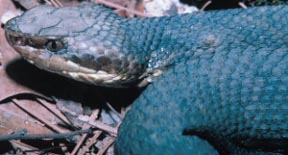Cottonmouth
Warning: Cottonmouths are dangerous (their bite can be fatal) and they should be left alone.
Description: These are relatively large heavy-bodied snakes that reach lengths between 30 and 48 in. (91-122 cm). Their coloration ranges from olive to brown to black and the young have wide, dark crossbands. The adult's coloration is dark so the banding pattern is usually not apparent.
Habitat/Range: Cottonmouths occupy marshes, swamps, and most other aquatic environments in the Coastal Plain and eastern Piedmont.
Reproduction: They mate during spring and fall and give birth to 1-15 young during late summer. The young are born with yellow tails.
Prey: Cottonmouths are mostly active at night when they feed on amphibians, fish, snakes, and birds. The specific epithet, "pisivorus", means "fish-eating."
Behavior: They closely resemble many of the water snakes in the genus Nerodia but they behave differently when confronted. Like other members of the pit viper family, they may shake their tail when aggravated. They are likely to stand their ground while opening their mouth and exposing the light lining of their mouth. The common name, Cottonmouth, is derived from this behavior. In many areas they are referred to as water moccasins.

